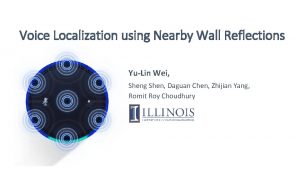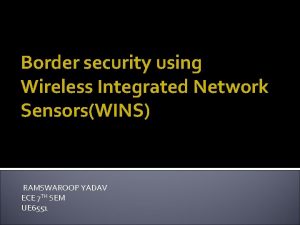ACOUSTIC SOURCE LOCALIZATION USING ACOUSTIC VECTOR SENSORS Joshua

- Slides: 1

ACOUSTIC SOURCE LOCALIZATION USING ACOUSTIC VECTOR SENSORS Joshua York , Patricio S. La Rosa, Ed Richter, and Arye Nehorai Department of Electrical and Systems Engineering Experimental Setup and GUI Azimuth and elevation estimation Abstract An acoustic vector sensor (AVS) measures all the three components of the acoustic particle velocity and the pressure at a single point in space. Through real experiments, the study evaluated the advantages of AVS for source localizing problems, compared with standard pressure sensor arrays. For this aim, we built a linear array of four AVS and design a graphical user interface for processing the measurements and estimating the source location in 3 D. This research considered the source identifiability using a single AVS, as well as 3 D location estimation using a linear array of AVS. Estimation algorithm Measurement model Acoustic source Illustration of the main components of our experimental setup Array of AVS Capon Spectra Far acoustic field Signal conditioner Euler equation DAQ pressure at position r and time t Overview Figure: Power distribution as a function of azimuth and elevation The red arrow indicates the maximum spectral value. particle velocity at position r and time t Goal direction of particle velocity Estimate the position of an acoustic source using spatial and temporal measurements of pressure and particle acoustic field speed of sound, Ambient pressure Single AVS and source model Approach SNR 1 = SNR 2 = SNR A) Single AVS • Physical modeling of the propagation of an acoustic waveform through the air. • Statistical analysis of pressure and particle velocity measurements taken by an array of acoustic vector sensors. pressure-sensor-measurement noise Applications Acoustic vector sensor (AVS) Assisted navigation, defense, teleconference, vibration analysis Background particle-velocity-measurement noise SNR = -3 d. B Multiple AVS and single source model B) Two AVS SNR = 6 d. B SNR = 12 d. B Numerical Example: References Source identifiability Pressure sensor Steering vector Particle velocity sensor • A. Nehorai and E. Paldi, ``Acoustic vector sensor array processing, " Proc. 26 th Asilomar Conf. Signals, Syst. Comput. , pp. 192 -198, Pacific Grove, CA, Oct. 1992. Figure: Photograph of a three dimensional sound intensity probe consisting of one pressure sensor and three particle velocity sensors mounted together (Source: Microflown Technologies, B. V. ) Capon Spectra sample-correlation matrix for N samples • A. Nehorai and E. Paldi, "Acoustic vector-sensor array processing, " IEEE Trans. on Signal Processing, Vol. SP-42, pp. 2481 -2491, Sept. 1994. • M. Hawkes and A. Nehorai, "Acoustic vector-sensor beamforming and capon direction estimation, " IEEE Trans. on Signal Processing, Vol. SP-46, pp. 2291 -2304, Sept. 1998.

